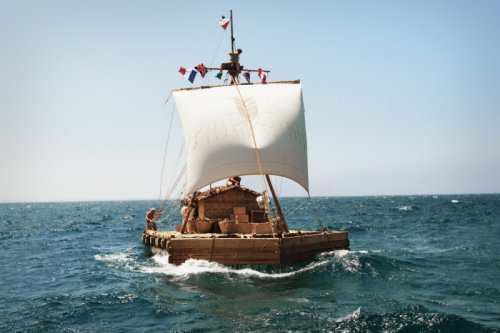Reviews - Kon Tiki
Kon Tiki
Reviewed By Vaughan Ames

Kon Tiki
In 1947 Thor Heyerdahl, a Norwegian ethnographer, had a theory that the first people to reach the Polynesian Islands had come from South America, not from the West as others thought. Everyone thought he was mad, so he set out to prove it was possible by recreating this voyage – nearly 5000 miles across the Pacific on the Kon Tiki, a raft made of balsawood (Tiki was the ancient name for the sun god). It won't be giving much away in advance to most people of my age at least to say he made it; the book he wrote sold 50 million copies and the documentary he filmed during the voyage won an Oscar. The whole adventure had the fame of the trip to the moon in the 1960s.
Strangely, perhaps, no-one has made a film based on the story until 2012, when Norwegian directors Joachim Rønning and Espen Sandberg made the film shown last weekend in Keswick. The film became the most expensive Norwegian film ever and the highest grossing film in Norway. It was nominated for the Best Foreign Language film at the Oscars, only the fifth Norwegian film to be nominated, which is also strange in a way as the film was actually filmed in both Norwegian AND English (each scene being shot twice!) – it was the English version we showed in Keswick.
So was it worth it? Many people knew the result, so not a thriller; 101 days floating at sea on a raft...maybe not even interesting? Well, the audience thought otherwise – 149 people turned out to see it and voted it the second highest score of the year in the feedback at the end.
The film started with Thor Heyerdahl's childhood, showing him to be brave and maybe a bit foolhardy by nature, certainly a showman. We then move to 1936 when he is on the island of Fatu Hiva in the Marquesas Islands with his wife Liv: he is studying the origins of the wild life there when he is told by a local tribesman that his people have come from the East, not the West as popular theory had it. We see Thor looking into the setting sun; the idea has been born.
Next, we jump to 1946 visiting what is obviously the latest in a long line of publishers that Heyerdahl is trying to get to publish his book – with no success; "No-one will believe you unless you can prove it is possible". Can he prove it? We next follow him to the National Geographic Society where he is trying to get funding to build the raft and rerun the voyage. They too cannot believe he has a hope "we are interested in funding genuine ideas, not suicide attempts".
The only person he comes across who believes him is a fridge salesman, Herman Watzinger who tells him he wants to go with him, who inspires Heyerdahl to travel to Lima with no backing, possibly starting his regular excuse for everything that can go wrong 'have faith in Tiki'.
Once in Lima, his luck turns and the Peruvian government back him and get the US Navy to give him supplies; the trip is on at last. A crew turns up (there is no attempt to explain where from – they are Norwegian friends who appear to have agreed in advance), they build the raft, and they are ready to go. (I did like the fact that 4 or 5 guys could pick up massive logs on their own – the one huge advantage of balsawood I guess!).
The voyage is not really full of incidents, given it lasts 101 days. We do see one major storm and a large whale approaching plus some electric eels and lots of sharks (fantastic photography for all of these events), but the film concentrates on the relationships between the crew and Heyerdahl's leadership. They portray Watzinger as becoming more and more afraid, causing several mishaps and eventually falling overboard amongst the sharks (again, well filmed and pretty scary!); Wikipedia tells me that this was all made up to add some action to the trip, but fair enough; it is fiction after all.
Eventually they reach Raroia, where they attempt to 'ride the surf' over the vicious reef (using an extra large wave), but they are 'raft-wrecked', coming ashore by wading. Success; they have made it; all is well! (except for the letter from Liv, bringing him down to earth in all senses – she loves him but cannot live with him any longer) Laughing and dancing follow, and the film ends with some black and white shots seemingly taken from the on-board camera (they were in fact remakes of the originals).
Next week we have the winner of the Palme d'Or at Cannes in 2014 – 'Winter Sleep'. A very different film which will be beautiful and thought-provoking, but be warned, is over 3 hours long so it will start at 4.00pm. I have been looking forward to this one all year...
Strangely, perhaps, no-one has made a film based on the story until 2012, when Norwegian directors Joachim Rønning and Espen Sandberg made the film shown last weekend in Keswick. The film became the most expensive Norwegian film ever and the highest grossing film in Norway. It was nominated for the Best Foreign Language film at the Oscars, only the fifth Norwegian film to be nominated, which is also strange in a way as the film was actually filmed in both Norwegian AND English (each scene being shot twice!) – it was the English version we showed in Keswick.
So was it worth it? Many people knew the result, so not a thriller; 101 days floating at sea on a raft...maybe not even interesting? Well, the audience thought otherwise – 149 people turned out to see it and voted it the second highest score of the year in the feedback at the end.
The film started with Thor Heyerdahl's childhood, showing him to be brave and maybe a bit foolhardy by nature, certainly a showman. We then move to 1936 when he is on the island of Fatu Hiva in the Marquesas Islands with his wife Liv: he is studying the origins of the wild life there when he is told by a local tribesman that his people have come from the East, not the West as popular theory had it. We see Thor looking into the setting sun; the idea has been born.
Next, we jump to 1946 visiting what is obviously the latest in a long line of publishers that Heyerdahl is trying to get to publish his book – with no success; "No-one will believe you unless you can prove it is possible". Can he prove it? We next follow him to the National Geographic Society where he is trying to get funding to build the raft and rerun the voyage. They too cannot believe he has a hope "we are interested in funding genuine ideas, not suicide attempts".
The only person he comes across who believes him is a fridge salesman, Herman Watzinger who tells him he wants to go with him, who inspires Heyerdahl to travel to Lima with no backing, possibly starting his regular excuse for everything that can go wrong 'have faith in Tiki'.
Once in Lima, his luck turns and the Peruvian government back him and get the US Navy to give him supplies; the trip is on at last. A crew turns up (there is no attempt to explain where from – they are Norwegian friends who appear to have agreed in advance), they build the raft, and they are ready to go. (I did like the fact that 4 or 5 guys could pick up massive logs on their own – the one huge advantage of balsawood I guess!).
The voyage is not really full of incidents, given it lasts 101 days. We do see one major storm and a large whale approaching plus some electric eels and lots of sharks (fantastic photography for all of these events), but the film concentrates on the relationships between the crew and Heyerdahl's leadership. They portray Watzinger as becoming more and more afraid, causing several mishaps and eventually falling overboard amongst the sharks (again, well filmed and pretty scary!); Wikipedia tells me that this was all made up to add some action to the trip, but fair enough; it is fiction after all.
Eventually they reach Raroia, where they attempt to 'ride the surf' over the vicious reef (using an extra large wave), but they are 'raft-wrecked', coming ashore by wading. Success; they have made it; all is well! (except for the letter from Liv, bringing him down to earth in all senses – she loves him but cannot live with him any longer) Laughing and dancing follow, and the film ends with some black and white shots seemingly taken from the on-board camera (they were in fact remakes of the originals).
Next week we have the winner of the Palme d'Or at Cannes in 2014 – 'Winter Sleep'. A very different film which will be beautiful and thought-provoking, but be warned, is over 3 hours long so it will start at 4.00pm. I have been looking forward to this one all year...
Find A Film
Search over 1475 films in the Keswick Film Club archive.
Friends
KFC is friends with Caldbeck Area Film Society and Brampton Film Club and members share benefits across all organisations
Awards
Keswick Film Club won the Best New Film Society at the British Federation Of Film Societies awards in 2000.
Since then, the club has won Film Society Of The Year and awards for Best Programme four times and Best Website twice.
We have also received numerous Distinctions and Commendations in categories including marketing, programming and website.
 Talking Pictures
The KFC Newsletter
Talking Pictures
The KFC Newsletter
Links Explore the internet with Keswick Film Club


